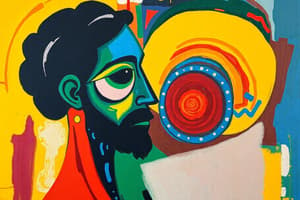Podcast
Questions and Answers
¿Cuál es uno de los conceptos principales de la filosofía dualista de Platón?
¿Cuál es uno de los conceptos principales de la filosofía dualista de Platón?
- La dualidad alma-cuerpo.
- La reencarnación.
- La dialéctica platónica.
- El Mundo de las Formas. (correct)
¿Cómo se accede a las Formas en el Mundo de las Formas según Platón?
¿Cómo se accede a las Formas en el Mundo de las Formas según Platón?
- Con la intervención divina.
- Por medio de la experiencia sensorial directa.
- A través de la contemplación. (correct)
- Mediante la reflexión racional.
¿Qué representan las Formas para Platón en su filosofía?
¿Qué representan las Formas para Platón en su filosofía?
- Ideas subjetivas creadas por la mente humana.
- Imágenes perfectas de la realidad material.
- La verdadera naturaleza o esencia de las cosas. (correct)
- Copias exactas y duraderas de los objetos físicos.
¿En qué consiste la dualidad alma-cuerpo según Platón?
¿En qué consiste la dualidad alma-cuerpo según Platón?
¿Cuál fue una consecuencia de la creencia en la dualidad alma-cuerpo según Platón?
¿Cuál fue una consecuencia de la creencia en la dualidad alma-cuerpo según Platón?
¿Cómo se relaciona la reencarnación con la filosofía de Platón?
¿Cómo se relaciona la reencarnación con la filosofía de Platón?
¿Según la filosofía de Platón, cómo se adquiere el conocimiento?
¿Según la filosofía de Platón, cómo se adquiere el conocimiento?
¿Cuál es el concepto que representa el nivel más alto de conocimiento en la Línea Dividida de Platón?
¿Cuál es el concepto que representa el nivel más alto de conocimiento en la Línea Dividida de Platón?
¿Qué representa la alegoría de la Cueva de Platón en La República?
¿Qué representa la alegoría de la Cueva de Platón en La República?
¿Qué afirmación describe mejor el dualismo alma-cuerpo en la filosofía platónica?
¿Qué afirmación describe mejor el dualismo alma-cuerpo en la filosofía platónica?
¿Qué campo filosófico se preocupa por la forma en que las personas adquieren conocimiento?
¿Qué campo filosófico se preocupa por la forma en que las personas adquieren conocimiento?
¿Cuál es la conexión principal entre la filosofía de Platón y las Formas en su concepto de la Línea Dividida?
¿Cuál es la conexión principal entre la filosofía de Platón y las Formas en su concepto de la Línea Dividida?
Study Notes
Plato's Dualistic Philosophy
Platonic dualism is a philosophical concept developed by the ancient Greek philosopher Plato. He proposed dualistic ideas in his work through two main concepts: the World of Forms and soul-body dualism. This philosophy also incorporates elements of various fields such as epistemology and metaphysics.
The World of Forms
The World of Forms, which Plato discusses in Phaedrus and other dialogues, includes the theory that there exists a realm made up of eternal, perfect Forms. These abstract entities are accessible through recollection. They represent the true nature or essence of things and are attained by contemplation. For instance, the form of a chair is perfect and everlasting. However, individual chairs we encounter are imperfect copies of the ultimate form they emulate. In Plato's ideal world, all living beings live in harmony within their respective forms.
Soul-Body Dualism
Plato believed in soul-body dualism, which posits two distinct kinds of existence. According to him, everything in the world consists of two parts – one being the physical body, the other being a non-physical entity known as the soul. His belief about souls led him to develop his concept of reincarnation. Souls come into human bodies and experience life, but after death, the soul leaves the body and goes on to another life.
Reincarnation
Reincarnation plays a significant role in Plato's philosophy. He proposed that when a person dies, their soul separates from the body and migrates to another body for rebirth. This cycle continues until a soul escapes the cycle of birth and death and eventually becomes part of the World of Forms.
Epistemology and Metaphysics
Epistemology concerns itself with how people gain knowledge, while metaphysics involves theories about reality beyond our senses. Both fields have strong connections to Plato's philosophies.
Knowledge vs Opinion
In Plato's view, knowledge is gained through direct contact with the Forms. He believed that knowledge is unchanging and cannot be altered by circumstances; therefore, only some types of knowledge can be possessed, such as mathematical knowledge. On the other hand, opinions change depending on the person's perspective and the situation.
The Forms and the Divided Line
The relationship between Plato's philosophy and the Forms can be found in his concept of the Divided Line. The Divided Line represents the different levels of knowledge and the relationship between them. The top part of the line represents the Forms. The second part represents the knowledge that humans can attain through their senses, such as color and sound. The third part represents the understanding of knowledge through mathematical concepts. The bottom part represents the understanding of knowledge through words.
The Cave Allegory
Another work in which Plato discusses epistemology is the Allegory of the Cave in The Republic. He uses the cave analogy to describe the process of learning and knowledge acquisition. The cave is a symbol of the physical world, where people are chained and can only see the shadows of objects passing by. The enlightened person is represented by the philosopher, who leaves the cave to see the true world of Forms.
In conclusion, Plato's philosophy of Platonic dualism encompasses a broad range of topics related to knowledge, reality, and the soul-body relationship. Through his ideas on the World of Forms, soul-body dualism, epistemology, and metaphysics, Plato has had a significant impact on Western philosophy.
Studying That Suits You
Use AI to generate personalized quizzes and flashcards to suit your learning preferences.
Description
Explore the key concepts of Platonic dualism, such as the World of Forms and soul-body dualism, as proposed by the ancient Greek philosopher Plato. Discover how his ideas on epistemology, metaphysics, and reincarnation have influenced Western philosophy.




